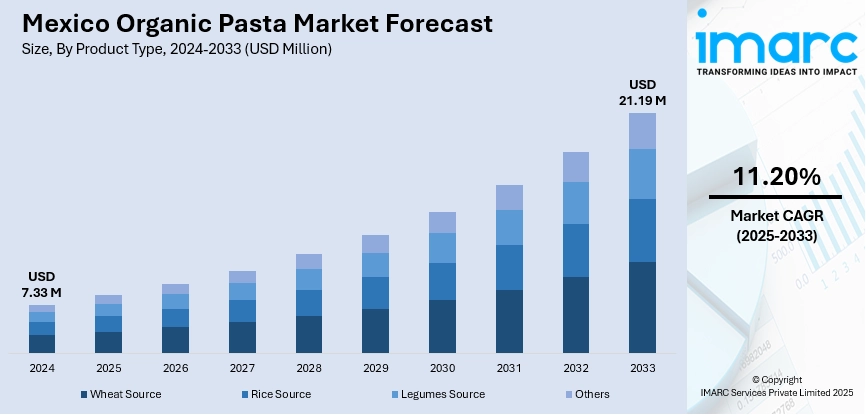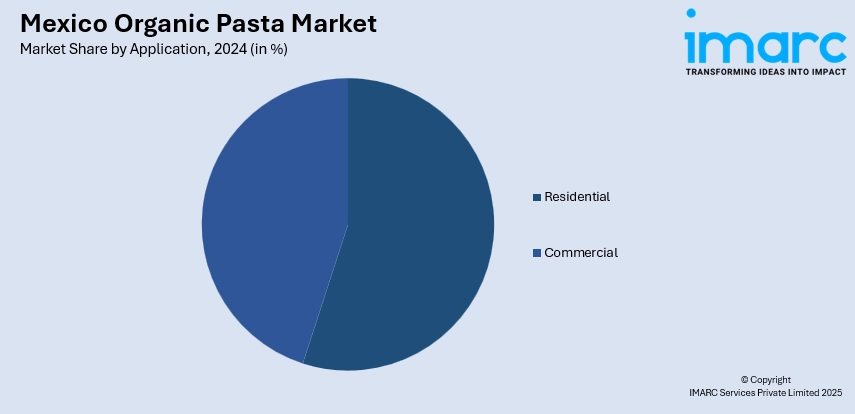
Mexico Organic Pasta Market Size, Share, Trends and Forecast by Product Type, Application, Distribution Channel, and Region, 2025-2033
Mexico Organic Pasta Market Overview:
The Mexico organic pasta market size reached USD 7.33 Million in 2024. Looking forward, IMARC Group expects the market to reach USD 21.19 Million by 2033, exhibiting a growth rate (CAGR) of 11.20% during 2025-2033. The market in Mexico is driven by growing health awareness, with consumers seeking natural, chemical-free foods that support wellness. Ethical consumption trends also play a role, as shoppers increasingly value transparency, sustainability, and fair production practices. Government support through certification standards and incentives for organic farming adds credibility and boosts supply. Additionally, rising environmental concerns are encouraging people to choose products like organic pasta that are linked to eco-friendly farming, reinforcing Mexico organic pasta market share across health-conscious and environmentally aware demographics.
|
Report Attribute
|
Key Statistics
|
|---|---|
|
Base Year
|
2024 |
|
Forecast Years
|
2025-2033
|
|
Historical Years
|
2019-2024
|
| Market Size in 2024 | USD 7.33 Million |
| Market Forecast in 2033 | USD 21.19 Million |
| Market Growth Rate 2025-2033 | 11.20% |
Mexico Organic Pasta Market Trends:
Health-Conscious and Ethical Consumption
Mexican consumers are becoming more mindful about what they eat, and organic pasta is benefiting from this shift. There’s a rising preference for food that’s free from synthetic additives and grown without pesticides. Organic pasta is seen as a cleaner, more natural option that fits into a healthier lifestyle. Additionally, consumers are paying more attention to food origins, ingredient transparency, and ethical production. This has led to increased interest in plant-based and non-GMO products, of which organic pasta is a part. Many shoppers now make choices that reflect both personal well-being and ethical values, such as environmental care and fair labor practices. This lifestyle-driven demand is influencing retail offerings, encouraging supermarkets and specialty stores to stock a greater variety of organic options, including pasta. Overall, a growing desire for clean eating and responsible consumption is driving Mexico organic pasta market growth.

To get more information on this market, Request Sample
Government Support and Certification Advancements
The organic pasta market in Mexico is gaining momentum, supported by government initiatives and clear certification standards. In 2023, Mexico had 571,608 hectares of certified organic land—60% for harvesting and 40% for crop production—reflecting the country’s commitment to organic farming. The government’s frameworks define what qualifies as organic, building trust and consistency for consumers. Programs encouraging sustainable agriculture make it easier for farmers to transition from conventional to organic practices. Rigorous certification offers credibility, assuring buyers of genuine organic products. These efforts also help local producers access both domestic and international markets, where demand for organic goods is growing. This structured support motivates producers to expand organic food production, including pasta, fostering innovation, greater availability, and more affordable options for consumers across Mexico.
Environmental Sustainability Concerns
Environmental awareness is playing a key role in the rise of Mexico organic pasta market trend. As people become more concerned about issues like soil health, biodiversity, and climate change, they are looking for food choices that align with their values. Organic farming avoids harmful chemicals and promotes more sustainable land use, which appeals to consumers who want to support practices that are better for the planet. For many, buying organic pasta isn’t just about personal health—it's a way to contribute to environmental conservation. This mindset is especially common in younger generations and urban areas, where access to information about food systems is easier. Brands that emphasize eco-friendly packaging, low carbon footprints, and organic sourcing often gain consumer loyalty. As sustainability becomes a priority in everyday decisions, the market for environmentally responsible foods like organic pasta continues to expand across Mexico.
Mexico Organic Pasta Market Segmentation:
IMARC Group provides an analysis of the key trends in each segment of the market, along with forecasts at the country and regional levels for 2025-2033. Our report has categorized the market based on product type, application, and distribution channel.
Product Type Insights:
- Wheat Source
- Rice Source
- Legumes Source
- Others
The report has provided a detailed breakup and analysis of the market based on the product type. This includes wheat source, rice source, legumes source, and others.
Application Insights:

- Residential
- Commercial
A detailed breakup and analysis of the market based on the application have also been provided in the report. This includes residential and commercial.
Distribution Channel Insights:
- Offline Stores
- Online Stores
The report has provided a detailed breakup and analysis of the market based on the distribution channel. This includes offline stores and online stores.
Regional Insights:
- Northern Mexico
- Central Mexico
- Southern Mexico
- Others
The report has also provided a comprehensive analysis of all the major regional markets, which include Northern Mexico, Central Mexico, Southern Mexico, and Others.
Competitive Landscape:
The market research report has also provided a comprehensive analysis of the competitive landscape. Competitive analysis such as market structure, key player positioning, top winning strategies, competitive dashboard, and company evaluation quadrant has been covered in the report. Also, detailed profiles of all major companies have been provided.
Mexico Organic Pasta Market News:
- In January 2025, Bionaturae launched its first line of Certified Organic Pasta Sauces, featuring Marinara, Arrabbiata, and Tomato & Basil flavors. Made with organic Tuscan tomatoes and premium Italian olive oil, the sauces are gluten-free, glyphosate-free, and non-GMO, with no added sugars or preservatives. Available exclusively at Whole Foods and online, these sauces combine authentic Italian flavors with a commitment to organic quality, sustainability, and health-conscious ingredients.
Mexico Organic Pasta Market Report Coverage:
| Report Features | Details |
|---|---|
| Base Year of the Analysis | 2024 |
| Historical Period | 2019-2024 |
| Forecast Period | 2025-2033 |
| Units | Million USD |
| Scope of the Report |
Exploration of Historical Trends and Market Outlook, Industry Catalysts and Challenges, Segment-Wise Historical and Future Market Assessment:
|
| Product Types Covered | Wheat Source, Rice Source, Legumes Source, Others |
| Applications Covered | Residential, Commercial |
| Distribution Channels Covered | Offline Stores, Online Stores |
| Regions Covered | Northern Mexico, Central Mexico, Southern Mexico, Others |
| Customization Scope | 10% Free Customization |
| Post-Sale Analyst Support | 10-12 Weeks |
| Delivery Format | PDF and Excel through Email (We can also provide the editable version of the report in PPT/Word format on special request) |
Key Questions Answered in This Report:
- How has the Mexico organic pasta market performed so far and how will it perform in the coming years?
- What is the breakup of the Mexico organic pasta market on the basis of product type?
- What is the breakup of the Mexico organic pasta market on the basis of application?
- What is the breakup of the Mexico organic pasta market on the basis of distribution channel?
- What is the breakup of the Mexico organic pasta market on the basis of region?
- What are the various stages in the value chain of the Mexico organic pasta market?
- What are the key driving factors and challenges in the Mexico organic pasta market?
- What is the structure of the Mexico organic pasta market and who are the key players?
- What is the degree of competition in the Mexico organic pasta market?
Key Benefits for Stakeholders:
- IMARC’s industry report offers a comprehensive quantitative analysis of various market segments, historical and current market trends, market forecasts, and dynamics of the Mexico organic pasta market from 2019-2033.
- The research report provides the latest information on the market drivers, challenges, and opportunities in the Mexico organic pasta market.
- Porter's five forces analysis assist stakeholders in assessing the impact of new entrants, competitive rivalry, supplier power, buyer power, and the threat of substitution. It helps stakeholders to analyze the level of competition within the Mexico organic pasta industry and its attractiveness.
- Competitive landscape allows stakeholders to understand their competitive environment and provides an insight into the current positions of key players in the market.
Need more help?
- Speak to our experienced analysts for insights on the current market scenarios.
- Include additional segments and countries to customize the report as per your requirement.
- Gain an unparalleled competitive advantage in your domain by understanding how to utilize the report and positively impacting your operations and revenue.
- For further assistance, please connect with our analysts.
 Request Customization
Request Customization
 Speak to an Analyst
Speak to an Analyst
 Request Brochure
Request Brochure
 Inquire Before Buying
Inquire Before Buying




.webp)




.webp)












